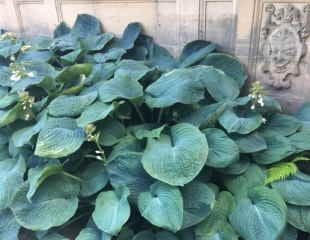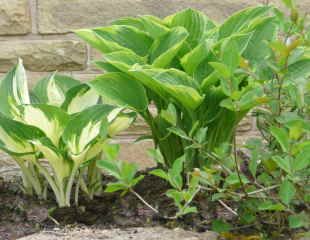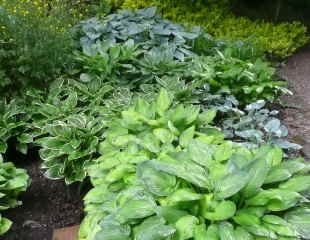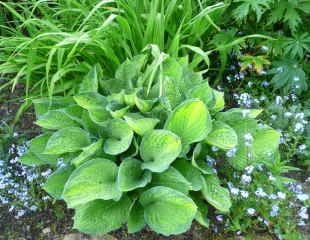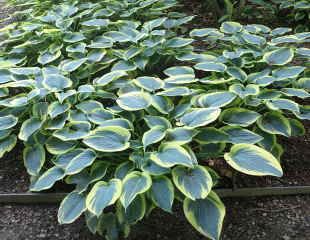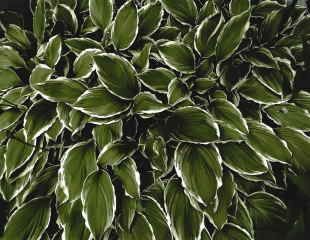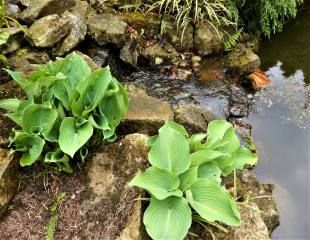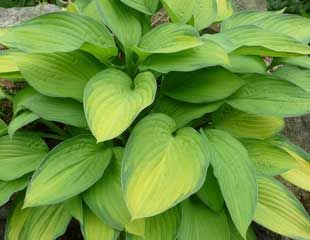
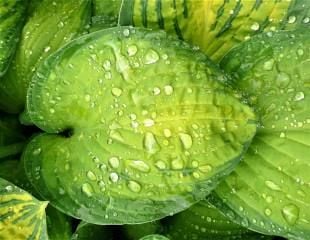
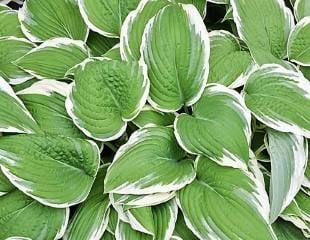
Growing Hostas
Hosta is a herbaceous perennial, which means dies back in the autumn to bare earth with new growth emerging in spring, quite late, around May. Although the earth looks bare over winter with nothing to be seen, Hosta returns reliably each year.
Hostas are grown for their impressive foliage, which varies in size and colour. Hostas are stylish, lush and shade tolerant a useful garden plant.
There are Hostas with bright green leaves, striped leaves, grey and blue leaves, gold and green and all different shades of green. Hosta vary in size, some are only a few centimetres ranging up to giant Hostas, which can grow up to a metre across and which make a dramatic statement in a border.
Hostas are fully hardy and tough. You can grow Hosta in semi- shade, and shade, in moist soil and even damp soil. Hosta are useful for planting in a sunless north facing border.
In terms of leaf colour, most Hostas grow best planted in semi shade. The general rule is that gold and yellow-leaved Hostas will tolerate more sunny conditions compared to those with green, blue and white leaves, which are better in shady areas. When you are deciding where to plant a Hosta, consider its eventual size and leaf shape. Some Hostas can grow very large and can congest a border.
You can buy Hostas from Suttons who have an extensive collection, including some value packs and large leaved varieties from £9.99 and also Crocus another good selection, (affiliate links)
Where to plant Hostas

Hostas are easy to grow, fully hardy and their preferred growing conditions include shade, semishade, and soil, which is moist, well drained and does not dry out. These are the ideal growing conditions.
That said, Hostas are tough. I have grown them in tubs and in walls, both of which are on the dry side. I always think that a Hosta planted in a corner spot displays well, as illustrated. If the only spot in your garden for the Hosta is sunny, try to avoid the midday /early afternoon. In a hot summer, the leaves can scorch if there is too much sun.
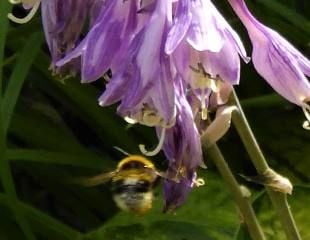
Although grown for their foliage, Hosta does flower in the summer. The flowers are spikes of blue or white and not terribly attractive and can become quite ragged not long after flowering. There is a gardening school of thought which recommends pruning off the flowers, so that the plant puts its energies into foliage.
The Hosta flowers may not look much to us, but they look good to the bees. Even though the flowers look quite spent and tired, as in the image right, the bees love them and for this reason; I leave the flowers intact.
Planting and dividing Hosta
When planting a new Hosta, set it so that the crown of the plant is at the same level as the existing soil. If the planting area is a little on the dry side, make a slight depression around the plant to create a mini well which will pool the water and help to get the Hosta established.
You can divide mature Hostas in the spring to make new plants. This is easy to do as Hosta is a tough plant. Dig it up and divide by either putting two spades in back to back and forcing apart, or cut a chunk off with a hacksaw or a sharp knife. Hostas are fairly indestructible, although the slugs and snails do a good job. Division is best in the spring when the shoots are first emerging.
In terms of maintenance, you can leave Hostas undisturbed for many years. They will welcome a mulch over winter/spring of organic material, but will soldier on fine without it if left alone.
Hostas look good planted in so many settings. Below are three traditional settings for hosta, grouped together in a woodland setting so they have the benefit of dappled shade in the spring and summer. Hosta also looks good planted alongside a pond or stream and team up well with ferns and Astilbes, which are also shade-loving plants.
How to deal with slugs and snails
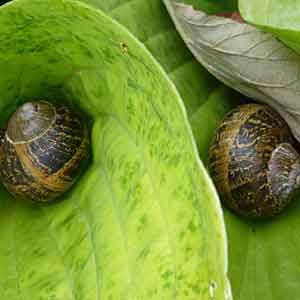
There is just one "but" when growing Hostas, which is slugs and snail. They can be ferocious. It is a sad fact of gardening that some gardens are more troubled by slugs and snails than some other gardens. If you have a lot of slugs and snails, it can be a struggle to grow Hostas, but with reasonable protection (follow this link for beat the slugs) you can have a healthy-looking plant for (at least part) of the summer.
You can also remove the worst affected leaves to tidy the plant. See more below.
For snails, it is vigilance, picking them off regularly before they have time to munch away.
Slug resistant Hostas
If your garden is especially prone to slugs and snails, you can grow the varieties which are sold as more slug resistant. These are the blue leaved varieties, and the larger Hosta, some of which have tougher leaves.
The varieties reputed to be more resistant to slugs are: the larger thicker leaved varieties such as Big Daddy, Gold Regal, Liberty, Halcyon, and Silvery Slugproof. This does work; I have planted the large blue leaved varieties and suffered much less damage.
The image below shows a much damaged Hosta where the snails have done their worst. The other step you can take is to reduce the appearance of the slug damage and before the slugs do too much damage. Early in the growing season, cut off the most badly affected leaves. As you do so, you will also see, near the base of the plant, fresh growth and leaves coming through. If you do this early in the season, although the plant will not be unscathed, but as a result of some judicious cutting will look better as in image below right.
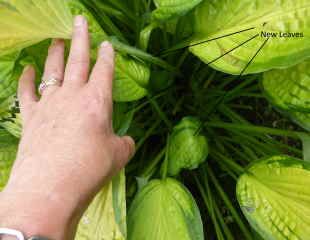
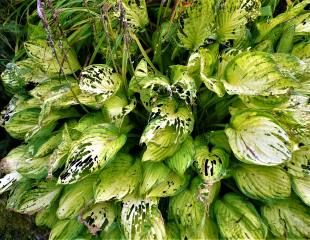
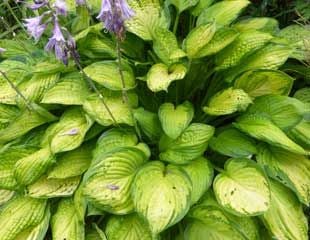
Hosta are herbaceous
Hostas are herbaceous, which means at the end of the summer, they die back and can look messy.
When the Hosta plants finally die back completely, there is just bare earth until the spring. Hostas are one of the earliest herbaceous plants to die back and can look untidy, it does no harm to the plant to cut back to ground level.
Come the spring, the new Hosta leaves push through the earth, spiking upwards and look very attractive as they unfurl.
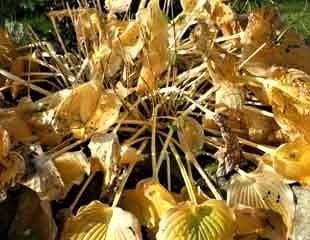

I have tagged Hostas amber wheelbarrow as a moderately difficult plant to grow, but only because of the problems with slugs and snails, apart from which they are very easy to grow.
Hosta Gallery - There are lots of different Hosta to choose from
